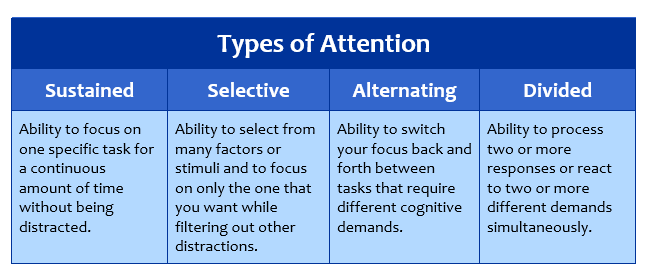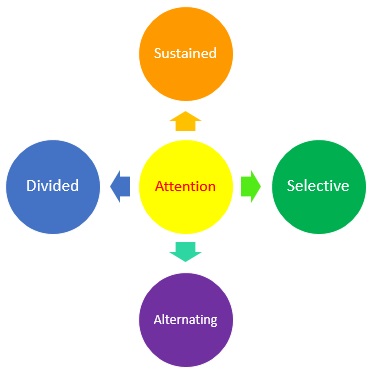Types of Attention
Attention is your brain function that allocates cognitive processing resources to focus on information or stimuli. It deals with how you mentally process specific information present in your environment that you are experiencing through your five senses.
Your attention span is your ability to keep your mind focused on something through careful observing or listening. It can be just momentarily such as turning around after hearing a loud noise, or it may be for a sustained period of time such as playing a video game.
Attention is often the beginning to other cognitive functions. You first must pay attention to something before you can process it for meaning and understanding.
Types of Attention
There are several types of attention that you use during the course of your daily activities. The type of attention you use will vary depending on your need and circumstances.
- Does the task need your undivided attention?
- Do you need to concentrate on one thing while ignoring other things that may be going on at the same time?
- Do you have to do two activities at the same time?
Depending on your needs and circumstances you may employ one of the following four types of attention.
Sustained attention is the ability to focus on one specific task for a continuous amount of time without being distracted.
Selective attention is the ability to select from many factors or stimuli and to focus on only the one that you want while filtering out other distractions.
Alternating attention is the ability to switch your focus back and forth between tasks that require different cognitive demands.
Divided attention is the ability to process two or more responses or react to two or more different demands simultaneously. Divided attention is often referred to as multi-tasking.
Categorizing Types of Attention
The first two types (sustained and selective) are needed when you have to focus on one thing at a time.
Sustained attention is used when you need to focus on one specific task or activity for a long period of time (playing a video game).
Selective attention is used to focus on one activity in the midst of many activities (listening to a friend at a loud party).
The other two types of attention (alternating and divided) are needed when a person has to focus on multiple things at once.
Alternating attention is used to alternate back and forth between tasks or activities (reading a recipe and preparing a meal).
Divided attention is used to complete two or more tasks simultaneously (talking on the phone while surfing the web)
Types of Attention Explained
Sustained Attention
Sustained attention is the ability to focus on one specific task for a continuous amount of time without being distracted. Sustained attention is probably what you think of when you hear the words “attention”, “focus”, “concentration”, or “vigilance.” You use sustained attention when you continuously maintain focus on one task or concentrate on an activity for a prolonged period of time without getting distracted. Examples of sustained attention may include listening to lecture, reading a book, playing a video, or fixing a car.
It can be challenging to maintain this type of attention for a significant amount of time without becoming distracted. Therefore, your level of sustained attention will often vary. You may be intensely focused one minute and then your attention may begin to lapse. However, a key aspect of sustained attention is the ability to re-focus on the task after a distraction arises.
Selective Attention
Selective attention is the ability to select from the various factors or stimuli that are present and to focus on only the one that you want. Every day, you are constantly exposed to a number of environmental factors or stimuli, but your brain naturally responds by selecting a particular aspect or factor to focus on. Selective attention basically allows you to be able to “select” what you want to pay attention to. You may need to use selective attention when attending a loud party and you are focusing on one person’s voice, or if you are trying to study in a noisy room.
When employing selective attention you are able to avoid distractions from both external (e.g. noise) and internal (e.g. thoughts) influences. If you are good at selective attention, you are good at ignoring distractions. You are able to maintain a specified level of performance in the presence of distracting stimuli.
Alternating Attention
Alternating attention is the ability of mental flexibility that allows you to shift your focus of attention and move between tasks having different cognitive requirements. It is alternating your attention back and forth between two different tasks that require the use of different areas your brain.
You probably use alternating attention almost all the time. You constantly need to make sudden changes on your activities or actions which requires your attention to shift. You may use alternating attention when reading a recipe (learning) and then performing the tasks of recipe (doing). It could also be alternating between unrelated tasks such as cooking while helping your child with her homework.
Divided Attention
Divided attention is the ability to process two or more responses or react to two or more different demands simultaneously. It is often referred to as multi-tasking. Basically, dividing your attention between two or more tasks.
Examples of divided attention include checking email while listening in a meeting, talking with friends while making dinner, or talking on the phone while getting dressed.
Unlike alternating attention, when you are using divided attention, you do not change from one task to another completely different task. Instead, you attempt to perform them at the same time. So you are really splitting your attention, instead of alternating it. Therefore, you are only really focusing part of attention on each task.
Although divided attention is thought of as the ability to focus on two or more stimuli or activities at the same time, it is humanly impossible to concentrate on two different tasks simultaneously. Your brain can only process one task at a time. So you are really not “focused” on one task at a time, you are really continuously alternating your attention between tasks. That is why it is so difficult and dangerous to text and drive or talk and drive.
You are able to use divided attention successfully because of muscle memory and/or habit. It allows you to perform two or more tasks seemingly simultaneously such as reading music and playing an instrument, talking to a person while typing, or driving your car while listening to the radio. However, you are really not focusing on hand positions when playing the instrument or concentrating on the individual acts of driving. You are able to do the task without conscious effort or actually paying attention.



